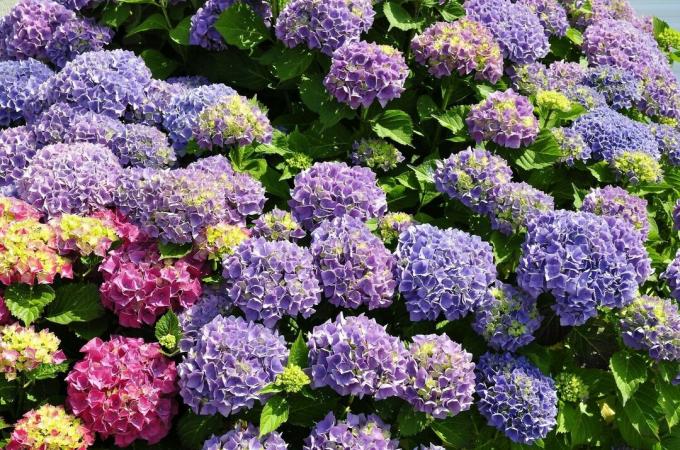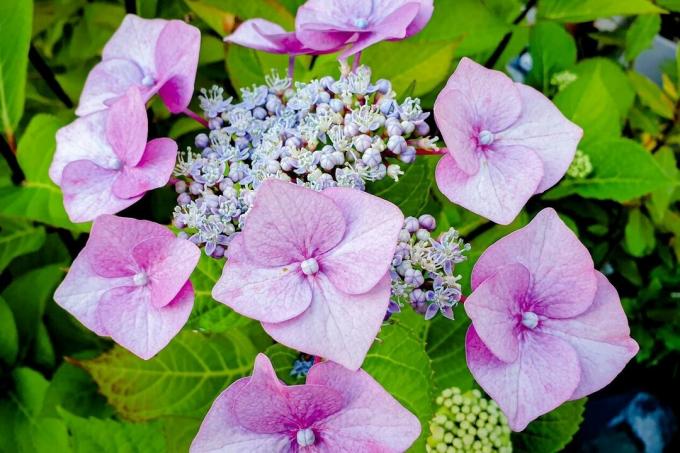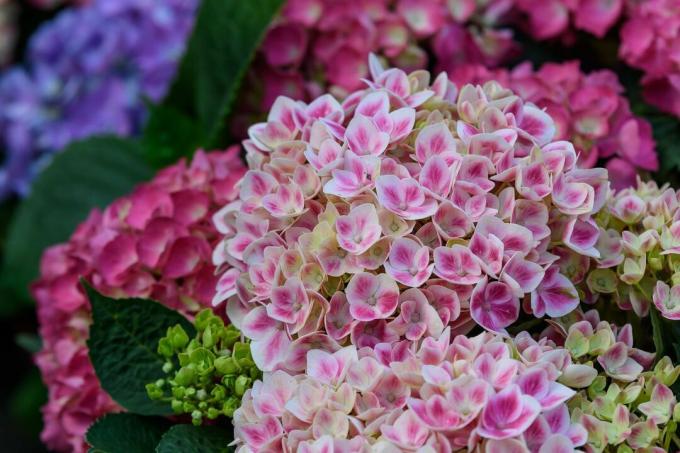Are farm hydrangeas, also known as garden hydrangeas, hardy? What should you watch out for when cutting farm hydrangeas? Everything about planting and caring for Hydrangea macrophylla can be found here.

Garden or farm hydrangeas have become an indispensable part of our gardens. Whether in white, pink, purple or blue - the plump inflorescences of the farm hydrangeas make shady garden areas glow.
contents
- Farm hydrangea: flowering period, origin and characteristics
-
Farm hydrangea varieties
- Hardy farm hydrangea varieties
- Farmer's hydrangeas in the tub: small varieties for the pot
-
Planting farm hydrangea: location, timing and instructions
- The right location for farm hydrangeas
- Instructions: Plant garden hydrangeas
-
Maintain farm hydrangea
- Cut farm hydrangeas
- Fertilize farm hydrangeas
- Water the farm hydrangeas
- Propagate garden hydrangeas
- Hibernate farm hydrangeas
Farm hydrangea: flowering period, origin and characteristics
The farmer's hydrangea (Hydrangea macrophylla) belongs to the genus of hydrangeas (Hydrangea) in the hydrangea family (Hydrangeaceae). Their wild form originally comes from Japan and came to Europe around 1790. Since then, it has been heavily cultivated in terms of breeding, so that today there is a large variety of garden hydrangea varieties. Under the designation garden resp. Farm hydrangeas also fall some lovely hybrid strains. The farmer's hydrangea grows as an upright subshrub and is about 1 to 2 meters high and up to 2.5 meters wide. It forms opposite, up to 15 centimeters long, elliptically pointed leaves. These appear in an intense green, their leaf margin is serrated. During the flowering period from June to September, numerous panicles of umbrella open above the foliage, consisting of sterile show flowers and hidden fertile flowers. The panicles have a flattened or spherical shape, with the spherical inflorescences being completely sterile.

The farmer's hydrangea forms lush panicles of flowers, but is it also bee-friendly? Unlike panicle hydrangeas, for example, garden hydrangeas have mostly sterile flowers with mostly 4 to 6 large sepals. Bees and other insects find no food in these. The farmer's hydrangea varieties with umbrella-shaped, flat inflorescences also have fertile flowers, which provide nectar and pollen, but the food supply for insects is comparatively small. The farmer's hydrangea is therefore only bee-friendly to a limited extent. If you are looking for an insect-friendly hydrangea, e. B. the panicle hydrangea variety ‘Kyushu’, which has a high proportion of fertile flowers rich in nectar.

Farm hydrangea varieties
There are many types of farmer's hydrangeas, which differ mainly in the color and shape of their flowers. In addition to single-colored varieties, unusual varieties with multi-colored flowers are also available.
Hardy farm hydrangea varieties
Farm hydrangea ‘Endless Summer’: Multiple flowering variety with plump, ball-shaped inflorescences in white, blue and red tones.
Farm hydrangea ‘Forever & Ever’: Easy-care variety series with ball-shaped inflorescences in pink, blue and purple; the edges of the sepals are partially slightly serrated.
Farm hydrangea ‘Hovaria’: Variety series with partially multi-colored pseudo-flowers, for example white with a red border or two-tone variegated flowers in pink and red; Leaf margins partly corrugated; provides food for bees.

Farm hydrangea Magical ’: Huge, ball-shaped flowers in shades of red and pink, also multi-colored varieties with unique color gradients from, for example, green to pink and red to yellow-green autumn colors; partially serrated flower edges.
Farm hydrangea ‘You & Me Romance’: Long-flowering variety with rather flat inflorescences, very large, double pseudo-flowers in pink or blue; provides food for bees.
farmershydrangea Pirates Gold ’: Conspicuous yellow-green leaf variegation; Inflorescences appear in pink and have only a few marginal pseudo-flowers; provides food for bees.
Farmer's hydrangeas in the tub: small varieties for the pot
Farm hydrangea ‘Little Blue’: Dwarf hydrangea, up to 60 cm in height; plump flower balls in pastel blue.
Farm hydrangea ‘Kanmara’: Large, ball-shaped inflorescences in white, pink, blue tones; also multicolored varieties; compact growth, very suitable as a container plant.
Farm hydrangea"Lanarth White": Small, broadly bushy shrub with plate-shaped inflorescences of pure white marginal flowers and pink or blue fertile flowers; the white farm hydrangea provides food for bees.

Planting farm hydrangea: location, timing and instructions
Garden hydrangeas can be planted all year round. However, spring is best. This gives the plants enough time until winter to grow well.
The right location for farm hydrangeas
The perfect location for garden hydrangeas is a partially shaded, sheltered place in the garden or on the balcony. Farm hydrangeas do not feel particularly comfortable in full sun, mainly because of their high water requirements. The irrigation water evaporates too quickly there, so that the plants let their leaves and flowers droop. In addition, they can easily get sunburned in strong sunlight.
Garden hydrangeas need a fresh, well-drained and slightly acidic soil with a high humus and nutrient content. Specialized hydrangea soils with a low pH value are available in specialist garden shops. These are very suitable for planting in pots. You can also easily make the substrate yourself in the garden. Sandy and nutrient-poor, but also too heavy and clayey garden soils should be mixed with high-quality potting soil like ours Plantura organic universal soil Mix. Particularly heavy soils are additionally enriched with sand, ideally in a mixing ratio of 2/3 garden soil to 1/3 sand. Mix acidic primary rock flour (e.g. basalt, granite) or grape pulp into the soil so that the soil pH value falls into the acidic range. The needles of conifers also have a pH-lowering effect.
After planting, the soil around the hydrangea should be mulched with bark. This keeps the moisture in the soil and ensures that the pH value remains rather low.
Tip: If you want to give your hydrangea a strong blue color, you should plant it in a pot, as the degree of acidity is easier to influence here. How exactly one Color hydrangeas blue can be found in our special article.
Instructions: Plant garden hydrangeas
Here's how you can plant a farmer's hydrangea in open ground or in a bucket:
- Dig a large enough planting hole for your hydrangea. It should be 1.5 times the size of the plant ball.
- Then fill the hole with loose soil until the correct planting height is reached.
- Loosen the hydrangea from the pot and loosen the plant ball with your hands so that huddled roots are pulled apart - that way the roots become branching stimulated.
- Place the plant ball in the center of the planting hole and fill it with substrate.
- Press down well and pour generously. Especially when planting in the summer months, the freshly placed hydrangeas must be watered very intensively.
If you want to plant the garden hydrangea in a bucket, it must have a drainage hole in the bottom of the container, which is kept free by thick stones or potsherds. Excess water can simply run off when watering, so that no waterlogging occurs. You should also choose a glazed clay pot or a plastic bucket for the farmer's hydrangea, as vessels made of open-pored clay lose a lot of water through evaporation.
Tip: The leftover earth can be used to form a small earth wall around the hydrangea, which is always completely filled with water when watering. In this way, the water can slowly seep away and does not flow off to the side if it cannot be absorbed by the ground quickly enough. A mulch layer of leaves or bark mulch also serves as protection against evaporation.

Maintain farm hydrangea
When caring for farmer's hydrangeas, you should note that the plants have an extremely high demand for water. In addition to regular watering, hydrangeas planted in pots in particular should be fertilized occasionally.
Tip: When caring for the beds, you should definitely avoid chopping around the hydrangeas. They are shallow roots and their roots can be easily damaged when hoeing.
Cut farm hydrangeas
In spring it is time to prune the farm hydrangeas. Only the withered inflorescences and the dead plant parts are removed. Place the secateurs below the flowers, just above the new buds. More detailed information on the topic Cut hydrangeas can be found in our special article.
Fertilize farm hydrangeas
Pot hydrangeas in particular should be fertilized annually to replenish the nutrient supply. The right time to apply fertilizer is spring. Spring fertilization gives garden hydrangeas a good start to the growing season. A second fertilization can be carried out in summer, but in no case should it be fertilized after the end of June, as the risk of frost damage increases then. Choose a special hydrangea fertilizer, such as our predominantly organic one Plantura organic hydrangea fertilizer with long-term effect. This contains extra iron to prevent iron chlorosis. Covering the fertilizer with a layer of mulch will keep it moist and start working faster. Do not work in the fertilizer by raking or the like, as this can easily damage the shallow roots of the hydrangeas. In our special article on the topic Fertilize hydrangeas find more helpful tips on how to properly fertilize your hydrangea plants.
Tip: Despite proper fertilization, iron chlorosis can occur in hydrangeas. The cause of this leaf discoloration, which is not typical for plants, is an excessively high pH value of the soil. This can be reduced by adding a little grape pulp or acidic bedrock flour or pouring acidic water regularly.
Water the farm hydrangeas
Unlike panicle hydrangeas, which can withstand shorter dry periods well, farmer's hydrangeas have an enormous impact high water demands and react quickly to a water deficit by making their shoots and flowers limp let hang. Water the garden hydrangeas generously in your garden or on the balcony during the summer months. On hot summer days, potted hydrangeas should even be watered twice a day, as the water evaporates faster with the smaller volume of soil. Ideally, use rainwater as it has the right pH for hydrangeas. The amount of water can be reduced towards the end of summer.
Tip: Water that is too lime should be acidified with a little apple cider vinegar or at least let stand for a day before using it ("let it bubble").
Propagate garden hydrangeas
Garden hydrangeas, like other hydrangea species, can be propagated using cuttings. These need to be cut in early summer between June and July. First, the growing vessels are filled with substrate. Choose a peat-free seed compost, such as ours Plantura organic herb & seed compost, and mix in sand or perlite. This increases the air capacity of the earth and thus improves the rooting. Then the cuttings can be cut. Cut off shoot tips about 10 to 15 cm long from the rods. They should be vital and only slightly lignified and not have any flower buds. Then remove the lower leaves, only the upper pair of leaves is left. Now the cuttings are inserted about 7 cm deep into the substrate and pressed on. The earth has to be kept moist continuously. In a bright place with high humidity, without direct sunlight and at a temperature of around 15 ° C, the cuttings take root and grow into new hydrangeas.
Hibernate farm hydrangeas
Farm hydrangeas are hardy in our latitudes. Always choose robust plants from specialist shops that have been well hardened. Since hydrangeas have very shallow roots, you can cover the ground around the hydrangeas with leaves and pine branches to be on the safe side. Especially with potted hydrangeas, the plants and pots should be covered with garden fleece and jute sacks to protect them from severe frosts.

Farm hydrangeas can also be overwintered in shelter in sheds or garages. However, the winter quarters must not be too warm. A long-lasting cold stimulus is necessary so that the plants sprout again successfully in the following year and form flowers. In spring, hydrangeas that have overwintered indoors must slowly be accustomed to the light again. Therefore, you should first put them in the shade and not in the blazing sun.
If you want to get an overview of all hydrangea types and want to find the right variety for your garden, we recommend our special article about Hydrangea species.
